System Analysis of Headspace: Cloud Solutions, SDLC, and Security
VerifiedAdded on 2022/11/13
|11
|2564
|413
Report
AI Summary
This report provides a system analysis of Headspace, a mental health intervention program, focusing on its non-functional requirements, cloud-based solutions, and the Software Development Life Cycle (SDLC) approach. The analysis covers aspects such as functionality, usability, reliability, performance, and security. The report also explores the advantages and disadvantages of cloud computing, specifically Platform as a Service (PaaS), as a potential solution for Headspace. Furthermore, it discusses the predictive and adaptive SDLC approaches, comparing their advantages and disadvantages in the context of the project. The report emphasizes the importance of security, data integrity, and system responsiveness for an effective system. The report also highlights the need for a menu-driven approach, clear messaging, and consistency in the user interface to enhance usability. The document also contains the project vision document focusing on the stakeholder map, questionnaire, and use case diagram for the new access mental health intervention system.
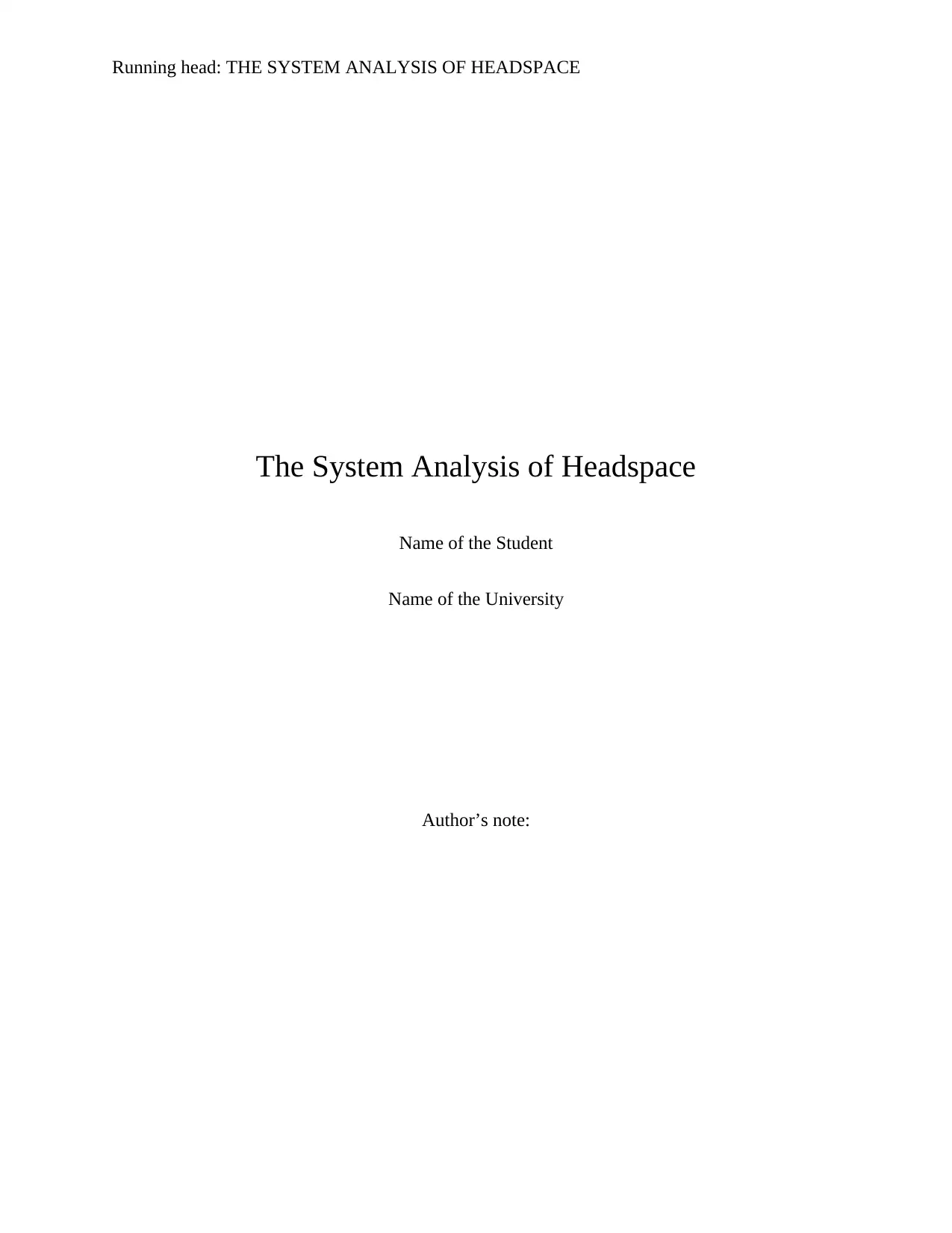
Running head: THE SYSTEM ANALYSIS OF HEADSPACE
The System Analysis of Headspace
Name of the Student
Name of the University
Author’s note:
The System Analysis of Headspace
Name of the Student
Name of the University
Author’s note:
Paraphrase This Document
Need a fresh take? Get an instant paraphrase of this document with our AI Paraphraser
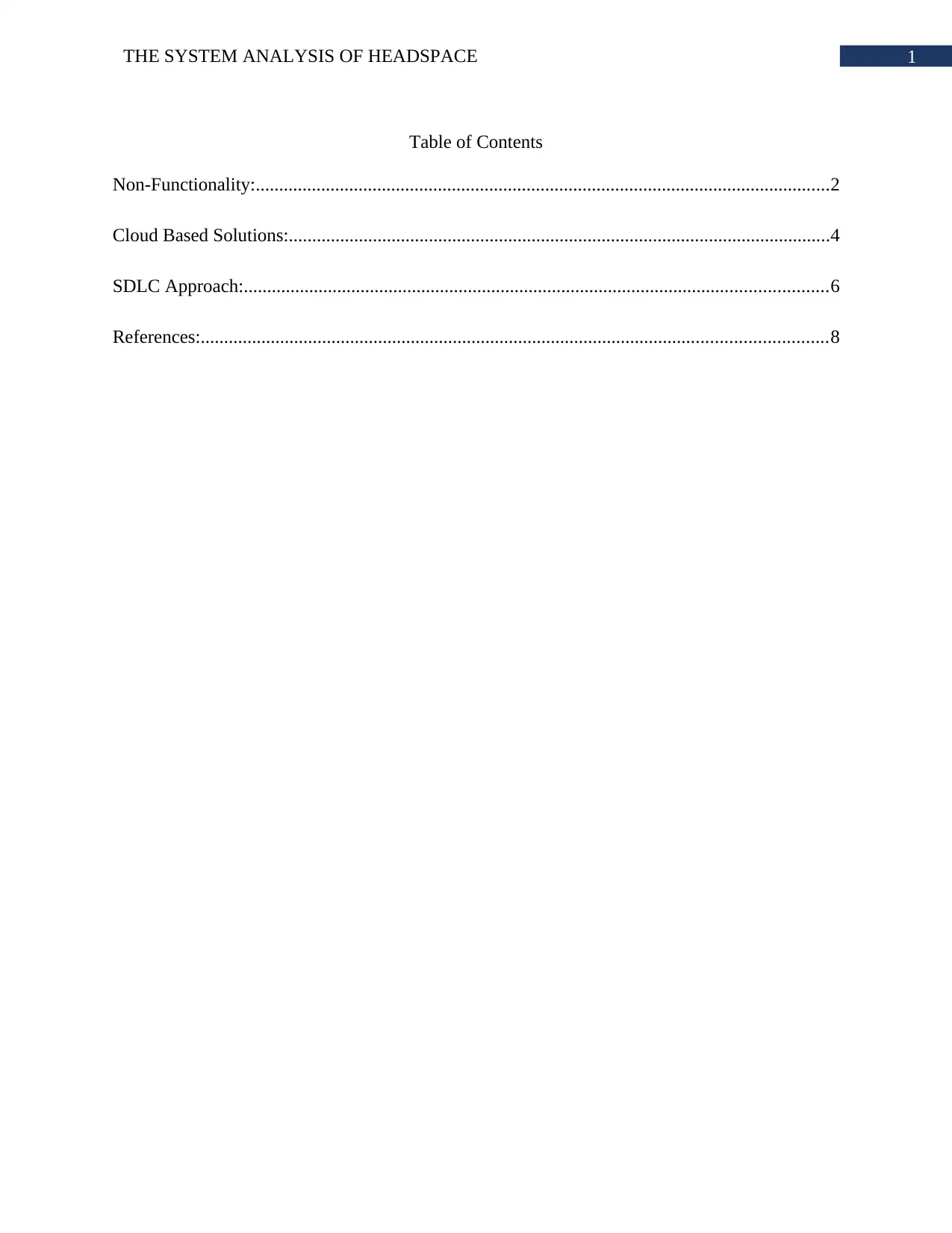
1THE SYSTEM ANALYSIS OF HEADSPACE
Table of Contents
Non-Functionality:...........................................................................................................................2
Cloud Based Solutions:....................................................................................................................4
SDLC Approach:.............................................................................................................................6
References:......................................................................................................................................8
Table of Contents
Non-Functionality:...........................................................................................................................2
Cloud Based Solutions:....................................................................................................................4
SDLC Approach:.............................................................................................................................6
References:......................................................................................................................................8
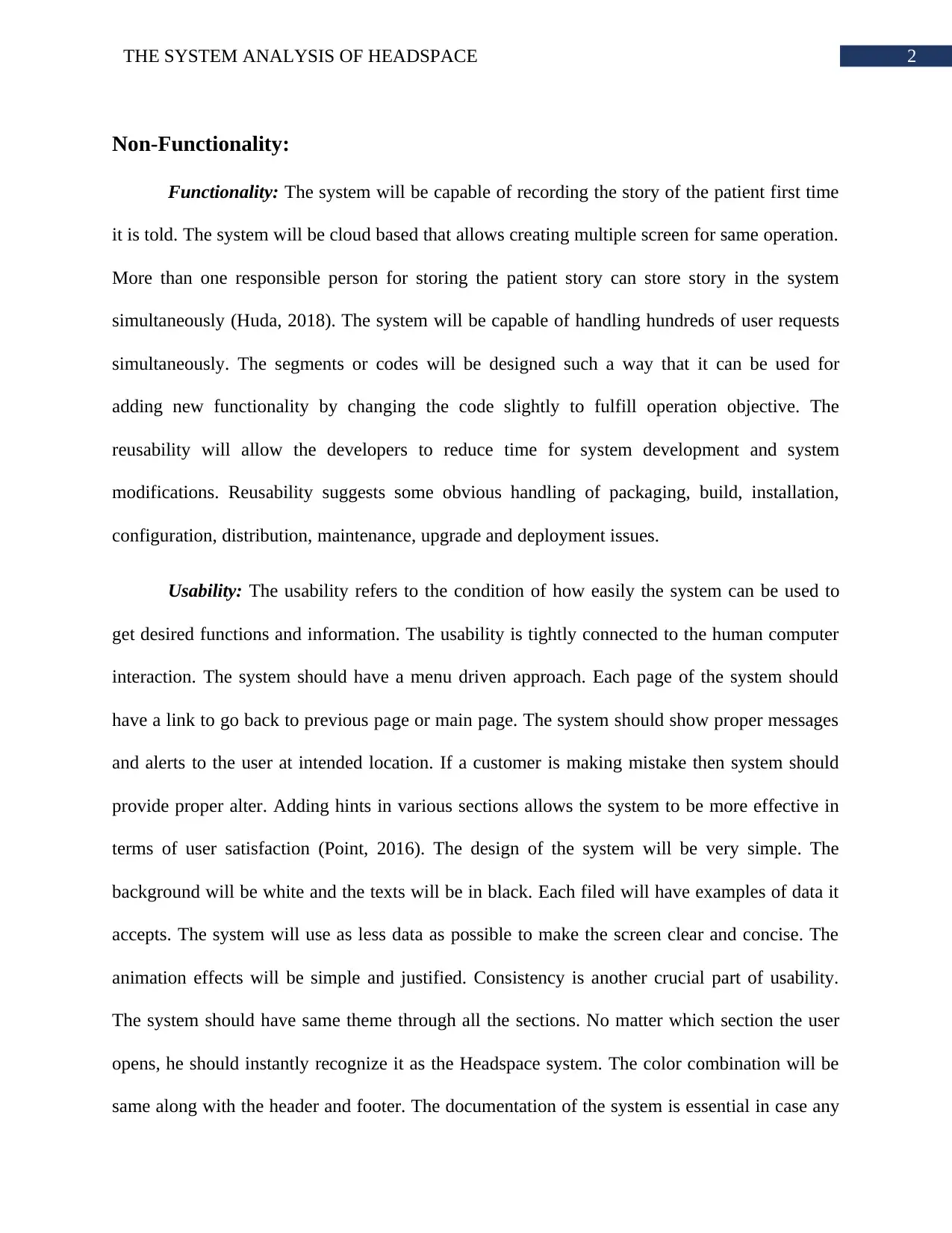
2THE SYSTEM ANALYSIS OF HEADSPACE
Non-Functionality:
Functionality: The system will be capable of recording the story of the patient first time
it is told. The system will be cloud based that allows creating multiple screen for same operation.
More than one responsible person for storing the patient story can store story in the system
simultaneously (Huda, 2018). The system will be capable of handling hundreds of user requests
simultaneously. The segments or codes will be designed such a way that it can be used for
adding new functionality by changing the code slightly to fulfill operation objective. The
reusability will allow the developers to reduce time for system development and system
modifications. Reusability suggests some obvious handling of packaging, build, installation,
configuration, distribution, maintenance, upgrade and deployment issues.
Usability: The usability refers to the condition of how easily the system can be used to
get desired functions and information. The usability is tightly connected to the human computer
interaction. The system should have a menu driven approach. Each page of the system should
have a link to go back to previous page or main page. The system should show proper messages
and alerts to the user at intended location. If a customer is making mistake then system should
provide proper alter. Adding hints in various sections allows the system to be more effective in
terms of user satisfaction (Point, 2016). The design of the system will be very simple. The
background will be white and the texts will be in black. Each filed will have examples of data it
accepts. The system will use as less data as possible to make the screen clear and concise. The
animation effects will be simple and justified. Consistency is another crucial part of usability.
The system should have same theme through all the sections. No matter which section the user
opens, he should instantly recognize it as the Headspace system. The color combination will be
same along with the header and footer. The documentation of the system is essential in case any
Non-Functionality:
Functionality: The system will be capable of recording the story of the patient first time
it is told. The system will be cloud based that allows creating multiple screen for same operation.
More than one responsible person for storing the patient story can store story in the system
simultaneously (Huda, 2018). The system will be capable of handling hundreds of user requests
simultaneously. The segments or codes will be designed such a way that it can be used for
adding new functionality by changing the code slightly to fulfill operation objective. The
reusability will allow the developers to reduce time for system development and system
modifications. Reusability suggests some obvious handling of packaging, build, installation,
configuration, distribution, maintenance, upgrade and deployment issues.
Usability: The usability refers to the condition of how easily the system can be used to
get desired functions and information. The usability is tightly connected to the human computer
interaction. The system should have a menu driven approach. Each page of the system should
have a link to go back to previous page or main page. The system should show proper messages
and alerts to the user at intended location. If a customer is making mistake then system should
provide proper alter. Adding hints in various sections allows the system to be more effective in
terms of user satisfaction (Point, 2016). The design of the system will be very simple. The
background will be white and the texts will be in black. Each filed will have examples of data it
accepts. The system will use as less data as possible to make the screen clear and concise. The
animation effects will be simple and justified. Consistency is another crucial part of usability.
The system should have same theme through all the sections. No matter which section the user
opens, he should instantly recognize it as the Headspace system. The color combination will be
same along with the header and footer. The documentation of the system is essential in case any
⊘ This is a preview!⊘
Do you want full access?
Subscribe today to unlock all pages.

Trusted by 1+ million students worldwide
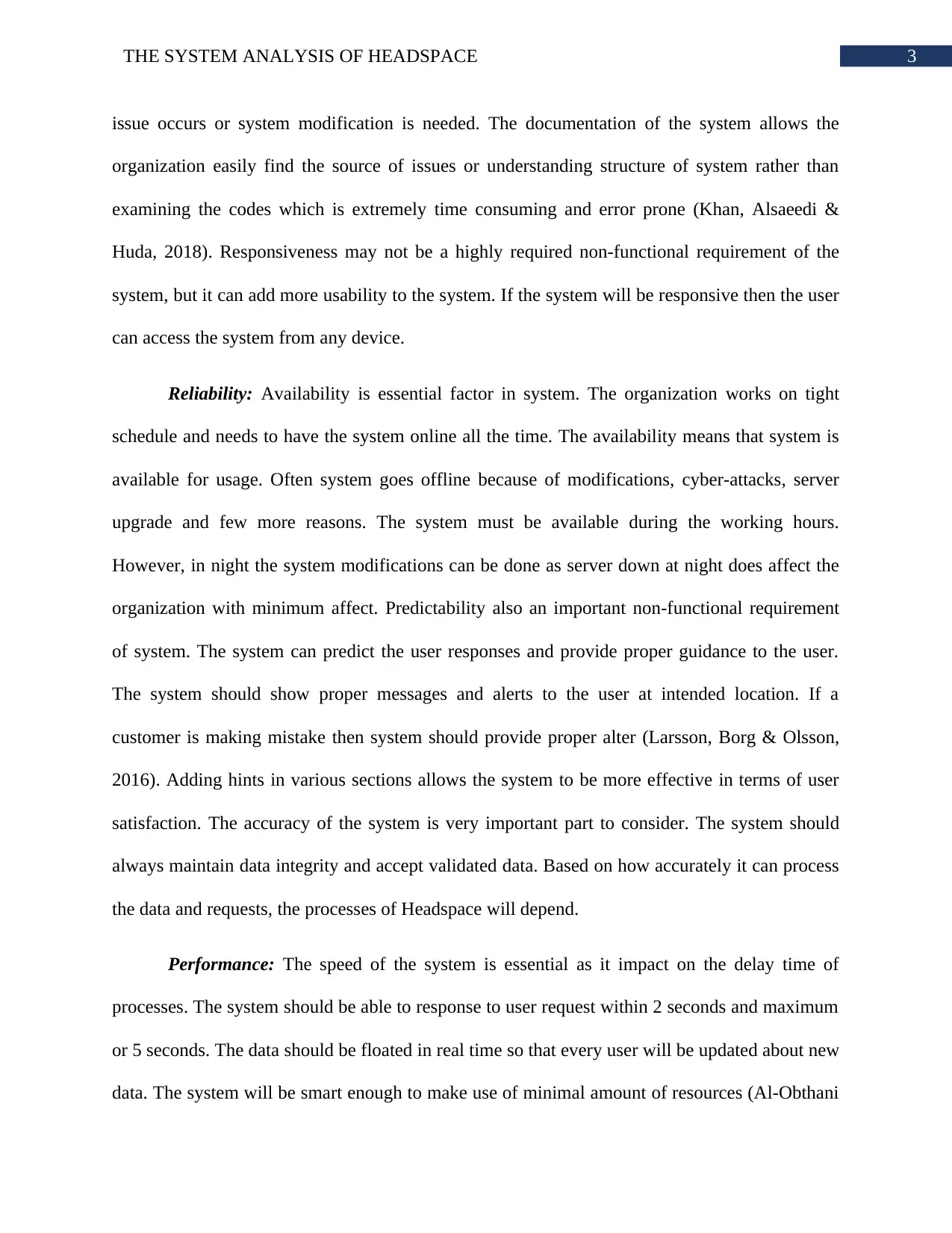
3THE SYSTEM ANALYSIS OF HEADSPACE
issue occurs or system modification is needed. The documentation of the system allows the
organization easily find the source of issues or understanding structure of system rather than
examining the codes which is extremely time consuming and error prone (Khan, Alsaeedi &
Huda, 2018). Responsiveness may not be a highly required non-functional requirement of the
system, but it can add more usability to the system. If the system will be responsive then the user
can access the system from any device.
Reliability: Availability is essential factor in system. The organization works on tight
schedule and needs to have the system online all the time. The availability means that system is
available for usage. Often system goes offline because of modifications, cyber-attacks, server
upgrade and few more reasons. The system must be available during the working hours.
However, in night the system modifications can be done as server down at night does affect the
organization with minimum affect. Predictability also an important non-functional requirement
of system. The system can predict the user responses and provide proper guidance to the user.
The system should show proper messages and alerts to the user at intended location. If a
customer is making mistake then system should provide proper alter (Larsson, Borg & Olsson,
2016). Adding hints in various sections allows the system to be more effective in terms of user
satisfaction. The accuracy of the system is very important part to consider. The system should
always maintain data integrity and accept validated data. Based on how accurately it can process
the data and requests, the processes of Headspace will depend.
Performance: The speed of the system is essential as it impact on the delay time of
processes. The system should be able to response to user request within 2 seconds and maximum
or 5 seconds. The data should be floated in real time so that every user will be updated about new
data. The system will be smart enough to make use of minimal amount of resources (Al-Obthani
issue occurs or system modification is needed. The documentation of the system allows the
organization easily find the source of issues or understanding structure of system rather than
examining the codes which is extremely time consuming and error prone (Khan, Alsaeedi &
Huda, 2018). Responsiveness may not be a highly required non-functional requirement of the
system, but it can add more usability to the system. If the system will be responsive then the user
can access the system from any device.
Reliability: Availability is essential factor in system. The organization works on tight
schedule and needs to have the system online all the time. The availability means that system is
available for usage. Often system goes offline because of modifications, cyber-attacks, server
upgrade and few more reasons. The system must be available during the working hours.
However, in night the system modifications can be done as server down at night does affect the
organization with minimum affect. Predictability also an important non-functional requirement
of system. The system can predict the user responses and provide proper guidance to the user.
The system should show proper messages and alerts to the user at intended location. If a
customer is making mistake then system should provide proper alter (Larsson, Borg & Olsson,
2016). Adding hints in various sections allows the system to be more effective in terms of user
satisfaction. The accuracy of the system is very important part to consider. The system should
always maintain data integrity and accept validated data. Based on how accurately it can process
the data and requests, the processes of Headspace will depend.
Performance: The speed of the system is essential as it impact on the delay time of
processes. The system should be able to response to user request within 2 seconds and maximum
or 5 seconds. The data should be floated in real time so that every user will be updated about new
data. The system will be smart enough to make use of minimal amount of resources (Al-Obthani
Paraphrase This Document
Need a fresh take? Get an instant paraphrase of this document with our AI Paraphraser
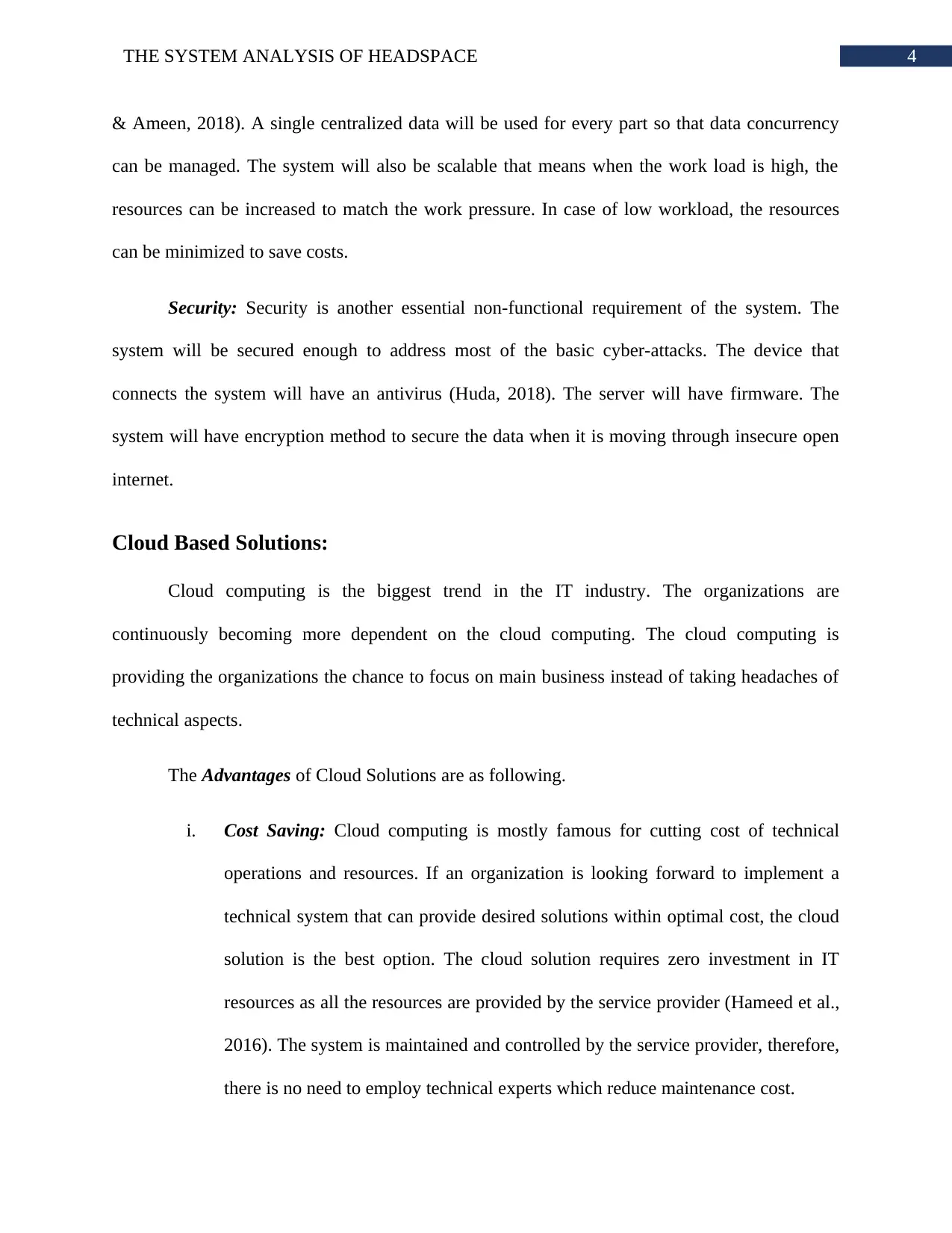
4THE SYSTEM ANALYSIS OF HEADSPACE
& Ameen, 2018). A single centralized data will be used for every part so that data concurrency
can be managed. The system will also be scalable that means when the work load is high, the
resources can be increased to match the work pressure. In case of low workload, the resources
can be minimized to save costs.
Security: Security is another essential non-functional requirement of the system. The
system will be secured enough to address most of the basic cyber-attacks. The device that
connects the system will have an antivirus (Huda, 2018). The server will have firmware. The
system will have encryption method to secure the data when it is moving through insecure open
internet.
Cloud Based Solutions:
Cloud computing is the biggest trend in the IT industry. The organizations are
continuously becoming more dependent on the cloud computing. The cloud computing is
providing the organizations the chance to focus on main business instead of taking headaches of
technical aspects.
The Advantages of Cloud Solutions are as following.
i. Cost Saving: Cloud computing is mostly famous for cutting cost of technical
operations and resources. If an organization is looking forward to implement a
technical system that can provide desired solutions within optimal cost, the cloud
solution is the best option. The cloud solution requires zero investment in IT
resources as all the resources are provided by the service provider (Hameed et al.,
2016). The system is maintained and controlled by the service provider, therefore,
there is no need to employ technical experts which reduce maintenance cost.
& Ameen, 2018). A single centralized data will be used for every part so that data concurrency
can be managed. The system will also be scalable that means when the work load is high, the
resources can be increased to match the work pressure. In case of low workload, the resources
can be minimized to save costs.
Security: Security is another essential non-functional requirement of the system. The
system will be secured enough to address most of the basic cyber-attacks. The device that
connects the system will have an antivirus (Huda, 2018). The server will have firmware. The
system will have encryption method to secure the data when it is moving through insecure open
internet.
Cloud Based Solutions:
Cloud computing is the biggest trend in the IT industry. The organizations are
continuously becoming more dependent on the cloud computing. The cloud computing is
providing the organizations the chance to focus on main business instead of taking headaches of
technical aspects.
The Advantages of Cloud Solutions are as following.
i. Cost Saving: Cloud computing is mostly famous for cutting cost of technical
operations and resources. If an organization is looking forward to implement a
technical system that can provide desired solutions within optimal cost, the cloud
solution is the best option. The cloud solution requires zero investment in IT
resources as all the resources are provided by the service provider (Hameed et al.,
2016). The system is maintained and controlled by the service provider, therefore,
there is no need to employ technical experts which reduce maintenance cost.
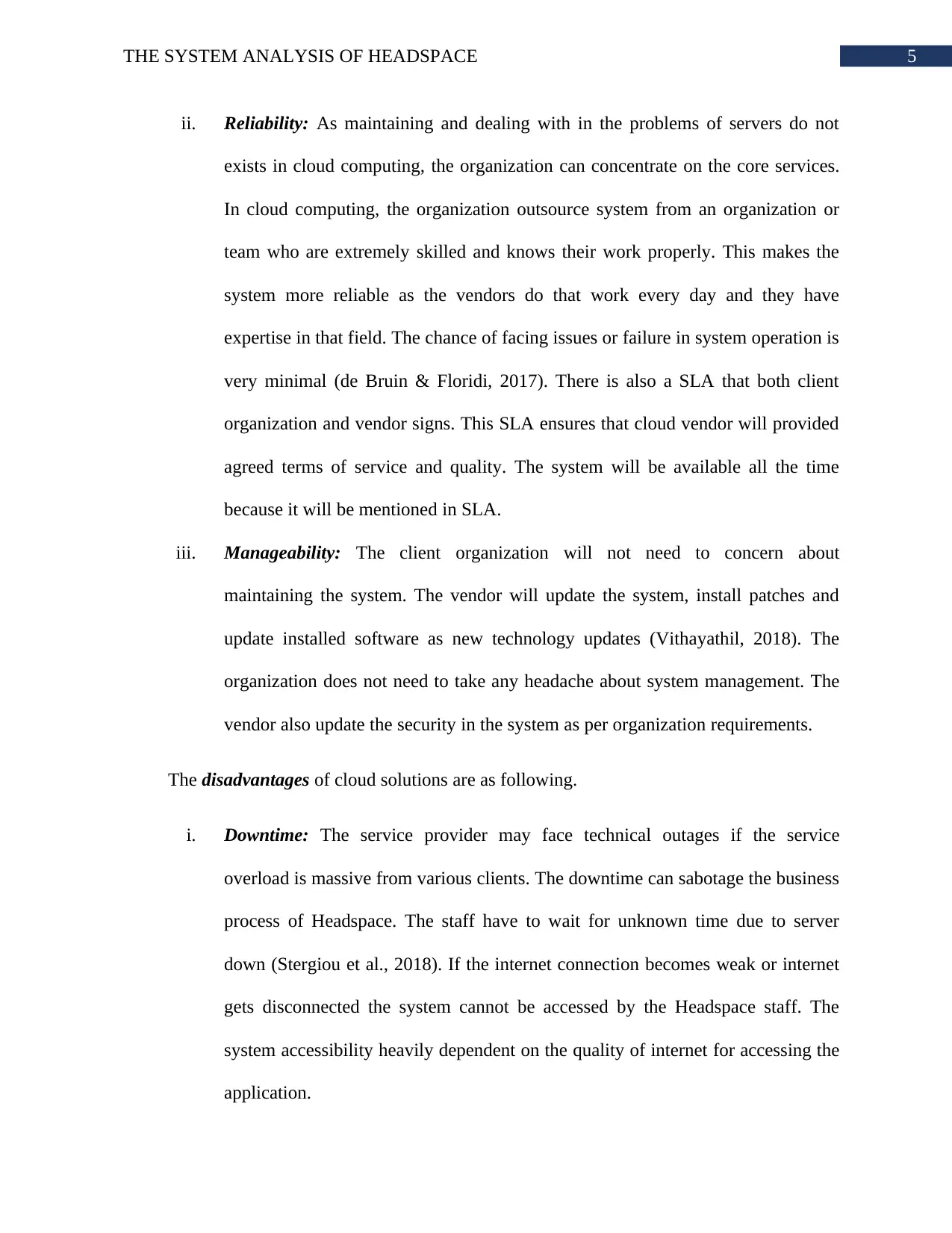
5THE SYSTEM ANALYSIS OF HEADSPACE
ii. Reliability: As maintaining and dealing with in the problems of servers do not
exists in cloud computing, the organization can concentrate on the core services.
In cloud computing, the organization outsource system from an organization or
team who are extremely skilled and knows their work properly. This makes the
system more reliable as the vendors do that work every day and they have
expertise in that field. The chance of facing issues or failure in system operation is
very minimal (de Bruin & Floridi, 2017). There is also a SLA that both client
organization and vendor signs. This SLA ensures that cloud vendor will provided
agreed terms of service and quality. The system will be available all the time
because it will be mentioned in SLA.
iii. Manageability: The client organization will not need to concern about
maintaining the system. The vendor will update the system, install patches and
update installed software as new technology updates (Vithayathil, 2018). The
organization does not need to take any headache about system management. The
vendor also update the security in the system as per organization requirements.
The disadvantages of cloud solutions are as following.
i. Downtime: The service provider may face technical outages if the service
overload is massive from various clients. The downtime can sabotage the business
process of Headspace. The staff have to wait for unknown time due to server
down (Stergiou et al., 2018). If the internet connection becomes weak or internet
gets disconnected the system cannot be accessed by the Headspace staff. The
system accessibility heavily dependent on the quality of internet for accessing the
application.
ii. Reliability: As maintaining and dealing with in the problems of servers do not
exists in cloud computing, the organization can concentrate on the core services.
In cloud computing, the organization outsource system from an organization or
team who are extremely skilled and knows their work properly. This makes the
system more reliable as the vendors do that work every day and they have
expertise in that field. The chance of facing issues or failure in system operation is
very minimal (de Bruin & Floridi, 2017). There is also a SLA that both client
organization and vendor signs. This SLA ensures that cloud vendor will provided
agreed terms of service and quality. The system will be available all the time
because it will be mentioned in SLA.
iii. Manageability: The client organization will not need to concern about
maintaining the system. The vendor will update the system, install patches and
update installed software as new technology updates (Vithayathil, 2018). The
organization does not need to take any headache about system management. The
vendor also update the security in the system as per organization requirements.
The disadvantages of cloud solutions are as following.
i. Downtime: The service provider may face technical outages if the service
overload is massive from various clients. The downtime can sabotage the business
process of Headspace. The staff have to wait for unknown time due to server
down (Stergiou et al., 2018). If the internet connection becomes weak or internet
gets disconnected the system cannot be accessed by the Headspace staff. The
system accessibility heavily dependent on the quality of internet for accessing the
application.
⊘ This is a preview!⊘
Do you want full access?
Subscribe today to unlock all pages.

Trusted by 1+ million students worldwide
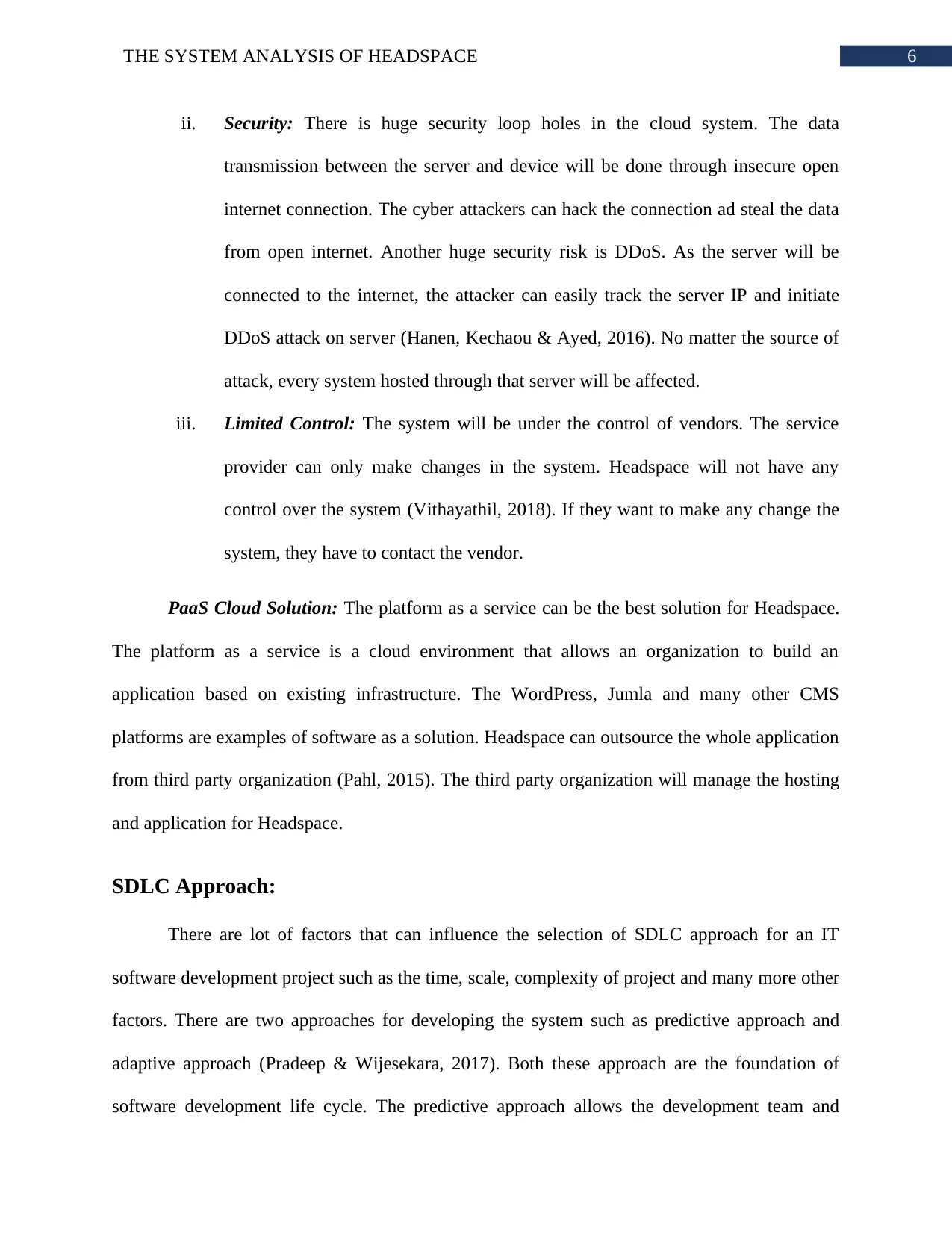
6THE SYSTEM ANALYSIS OF HEADSPACE
ii. Security: There is huge security loop holes in the cloud system. The data
transmission between the server and device will be done through insecure open
internet connection. The cyber attackers can hack the connection ad steal the data
from open internet. Another huge security risk is DDoS. As the server will be
connected to the internet, the attacker can easily track the server IP and initiate
DDoS attack on server (Hanen, Kechaou & Ayed, 2016). No matter the source of
attack, every system hosted through that server will be affected.
iii. Limited Control: The system will be under the control of vendors. The service
provider can only make changes in the system. Headspace will not have any
control over the system (Vithayathil, 2018). If they want to make any change the
system, they have to contact the vendor.
PaaS Cloud Solution: The platform as a service can be the best solution for Headspace.
The platform as a service is a cloud environment that allows an organization to build an
application based on existing infrastructure. The WordPress, Jumla and many other CMS
platforms are examples of software as a solution. Headspace can outsource the whole application
from third party organization (Pahl, 2015). The third party organization will manage the hosting
and application for Headspace.
SDLC Approach:
There are lot of factors that can influence the selection of SDLC approach for an IT
software development project such as the time, scale, complexity of project and many more other
factors. There are two approaches for developing the system such as predictive approach and
adaptive approach (Pradeep & Wijesekara, 2017). Both these approach are the foundation of
software development life cycle. The predictive approach allows the development team and
ii. Security: There is huge security loop holes in the cloud system. The data
transmission between the server and device will be done through insecure open
internet connection. The cyber attackers can hack the connection ad steal the data
from open internet. Another huge security risk is DDoS. As the server will be
connected to the internet, the attacker can easily track the server IP and initiate
DDoS attack on server (Hanen, Kechaou & Ayed, 2016). No matter the source of
attack, every system hosted through that server will be affected.
iii. Limited Control: The system will be under the control of vendors. The service
provider can only make changes in the system. Headspace will not have any
control over the system (Vithayathil, 2018). If they want to make any change the
system, they have to contact the vendor.
PaaS Cloud Solution: The platform as a service can be the best solution for Headspace.
The platform as a service is a cloud environment that allows an organization to build an
application based on existing infrastructure. The WordPress, Jumla and many other CMS
platforms are examples of software as a solution. Headspace can outsource the whole application
from third party organization (Pahl, 2015). The third party organization will manage the hosting
and application for Headspace.
SDLC Approach:
There are lot of factors that can influence the selection of SDLC approach for an IT
software development project such as the time, scale, complexity of project and many more other
factors. There are two approaches for developing the system such as predictive approach and
adaptive approach (Pradeep & Wijesekara, 2017). Both these approach are the foundation of
software development life cycle. The predictive approach allows the development team and
Paraphrase This Document
Need a fresh take? Get an instant paraphrase of this document with our AI Paraphraser
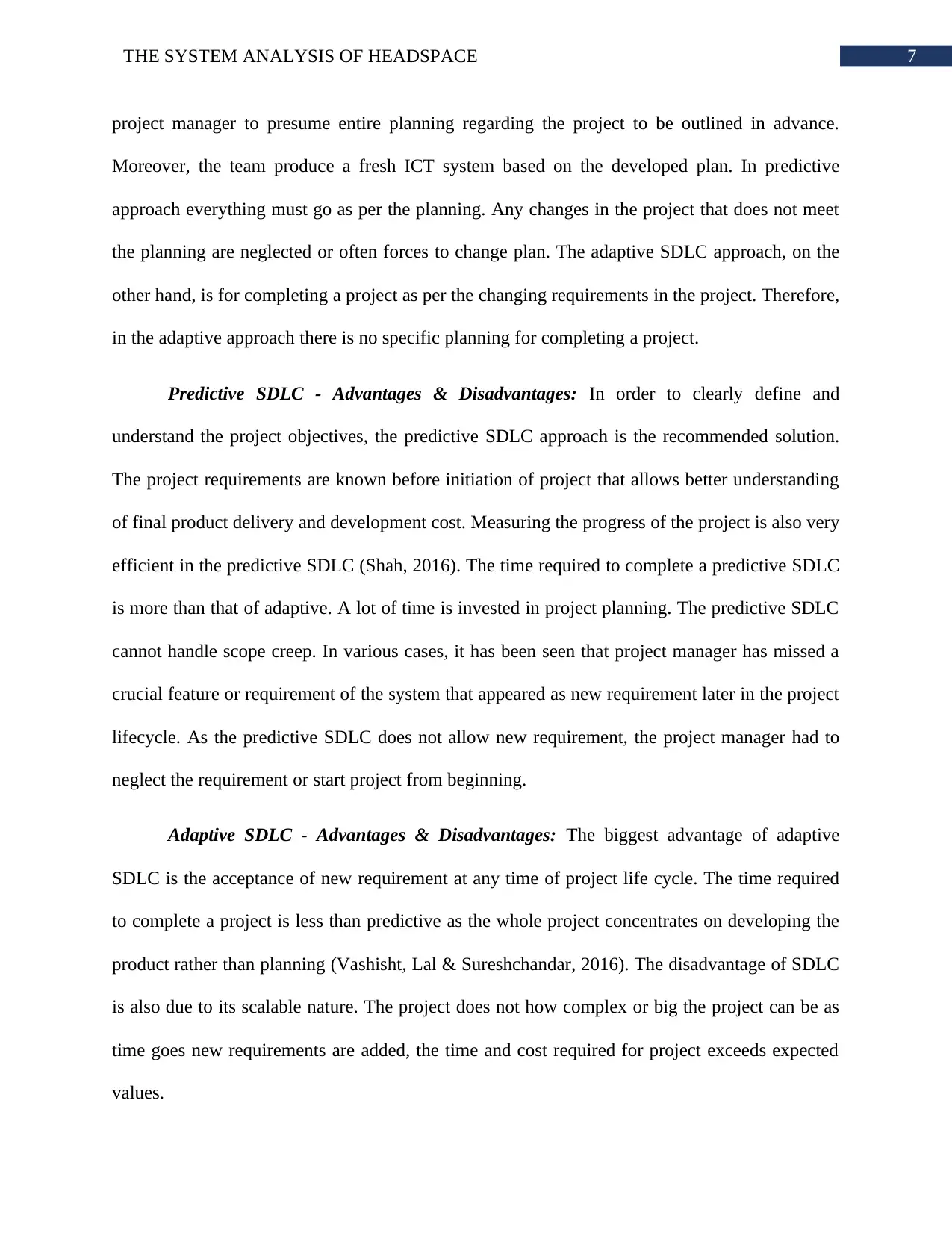
7THE SYSTEM ANALYSIS OF HEADSPACE
project manager to presume entire planning regarding the project to be outlined in advance.
Moreover, the team produce a fresh ICT system based on the developed plan. In predictive
approach everything must go as per the planning. Any changes in the project that does not meet
the planning are neglected or often forces to change plan. The adaptive SDLC approach, on the
other hand, is for completing a project as per the changing requirements in the project. Therefore,
in the adaptive approach there is no specific planning for completing a project.
Predictive SDLC - Advantages & Disadvantages: In order to clearly define and
understand the project objectives, the predictive SDLC approach is the recommended solution.
The project requirements are known before initiation of project that allows better understanding
of final product delivery and development cost. Measuring the progress of the project is also very
efficient in the predictive SDLC (Shah, 2016). The time required to complete a predictive SDLC
is more than that of adaptive. A lot of time is invested in project planning. The predictive SDLC
cannot handle scope creep. In various cases, it has been seen that project manager has missed a
crucial feature or requirement of the system that appeared as new requirement later in the project
lifecycle. As the predictive SDLC does not allow new requirement, the project manager had to
neglect the requirement or start project from beginning.
Adaptive SDLC - Advantages & Disadvantages: The biggest advantage of adaptive
SDLC is the acceptance of new requirement at any time of project life cycle. The time required
to complete a project is less than predictive as the whole project concentrates on developing the
product rather than planning (Vashisht, Lal & Sureshchandar, 2016). The disadvantage of SDLC
is also due to its scalable nature. The project does not how complex or big the project can be as
time goes new requirements are added, the time and cost required for project exceeds expected
values.
project manager to presume entire planning regarding the project to be outlined in advance.
Moreover, the team produce a fresh ICT system based on the developed plan. In predictive
approach everything must go as per the planning. Any changes in the project that does not meet
the planning are neglected or often forces to change plan. The adaptive SDLC approach, on the
other hand, is for completing a project as per the changing requirements in the project. Therefore,
in the adaptive approach there is no specific planning for completing a project.
Predictive SDLC - Advantages & Disadvantages: In order to clearly define and
understand the project objectives, the predictive SDLC approach is the recommended solution.
The project requirements are known before initiation of project that allows better understanding
of final product delivery and development cost. Measuring the progress of the project is also very
efficient in the predictive SDLC (Shah, 2016). The time required to complete a predictive SDLC
is more than that of adaptive. A lot of time is invested in project planning. The predictive SDLC
cannot handle scope creep. In various cases, it has been seen that project manager has missed a
crucial feature or requirement of the system that appeared as new requirement later in the project
lifecycle. As the predictive SDLC does not allow new requirement, the project manager had to
neglect the requirement or start project from beginning.
Adaptive SDLC - Advantages & Disadvantages: The biggest advantage of adaptive
SDLC is the acceptance of new requirement at any time of project life cycle. The time required
to complete a project is less than predictive as the whole project concentrates on developing the
product rather than planning (Vashisht, Lal & Sureshchandar, 2016). The disadvantage of SDLC
is also due to its scalable nature. The project does not how complex or big the project can be as
time goes new requirements are added, the time and cost required for project exceeds expected
values.

8THE SYSTEM ANALYSIS OF HEADSPACE
⊘ This is a preview!⊘
Do you want full access?
Subscribe today to unlock all pages.

Trusted by 1+ million students worldwide
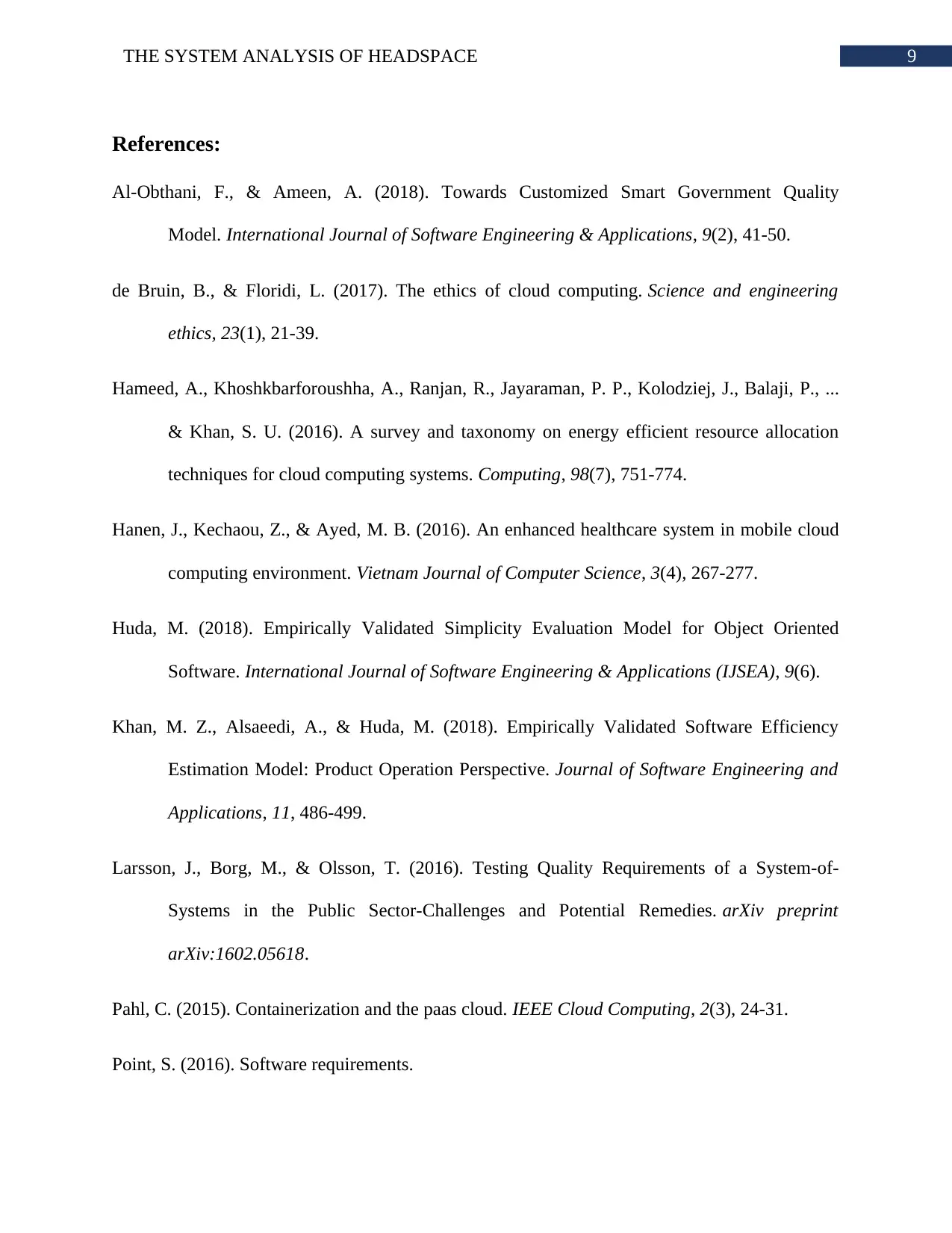
9THE SYSTEM ANALYSIS OF HEADSPACE
References:
Al-Obthani, F., & Ameen, A. (2018). Towards Customized Smart Government Quality
Model. International Journal of Software Engineering & Applications, 9(2), 41-50.
de Bruin, B., & Floridi, L. (2017). The ethics of cloud computing. Science and engineering
ethics, 23(1), 21-39.
Hameed, A., Khoshkbarforoushha, A., Ranjan, R., Jayaraman, P. P., Kolodziej, J., Balaji, P., ...
& Khan, S. U. (2016). A survey and taxonomy on energy efficient resource allocation
techniques for cloud computing systems. Computing, 98(7), 751-774.
Hanen, J., Kechaou, Z., & Ayed, M. B. (2016). An enhanced healthcare system in mobile cloud
computing environment. Vietnam Journal of Computer Science, 3(4), 267-277.
Huda, M. (2018). Empirically Validated Simplicity Evaluation Model for Object Oriented
Software. International Journal of Software Engineering & Applications (IJSEA), 9(6).
Khan, M. Z., Alsaeedi, A., & Huda, M. (2018). Empirically Validated Software Efficiency
Estimation Model: Product Operation Perspective. Journal of Software Engineering and
Applications, 11, 486-499.
Larsson, J., Borg, M., & Olsson, T. (2016). Testing Quality Requirements of a System-of-
Systems in the Public Sector-Challenges and Potential Remedies. arXiv preprint
arXiv:1602.05618.
Pahl, C. (2015). Containerization and the paas cloud. IEEE Cloud Computing, 2(3), 24-31.
Point, S. (2016). Software requirements.
References:
Al-Obthani, F., & Ameen, A. (2018). Towards Customized Smart Government Quality
Model. International Journal of Software Engineering & Applications, 9(2), 41-50.
de Bruin, B., & Floridi, L. (2017). The ethics of cloud computing. Science and engineering
ethics, 23(1), 21-39.
Hameed, A., Khoshkbarforoushha, A., Ranjan, R., Jayaraman, P. P., Kolodziej, J., Balaji, P., ...
& Khan, S. U. (2016). A survey and taxonomy on energy efficient resource allocation
techniques for cloud computing systems. Computing, 98(7), 751-774.
Hanen, J., Kechaou, Z., & Ayed, M. B. (2016). An enhanced healthcare system in mobile cloud
computing environment. Vietnam Journal of Computer Science, 3(4), 267-277.
Huda, M. (2018). Empirically Validated Simplicity Evaluation Model for Object Oriented
Software. International Journal of Software Engineering & Applications (IJSEA), 9(6).
Khan, M. Z., Alsaeedi, A., & Huda, M. (2018). Empirically Validated Software Efficiency
Estimation Model: Product Operation Perspective. Journal of Software Engineering and
Applications, 11, 486-499.
Larsson, J., Borg, M., & Olsson, T. (2016). Testing Quality Requirements of a System-of-
Systems in the Public Sector-Challenges and Potential Remedies. arXiv preprint
arXiv:1602.05618.
Pahl, C. (2015). Containerization and the paas cloud. IEEE Cloud Computing, 2(3), 24-31.
Point, S. (2016). Software requirements.
Paraphrase This Document
Need a fresh take? Get an instant paraphrase of this document with our AI Paraphraser
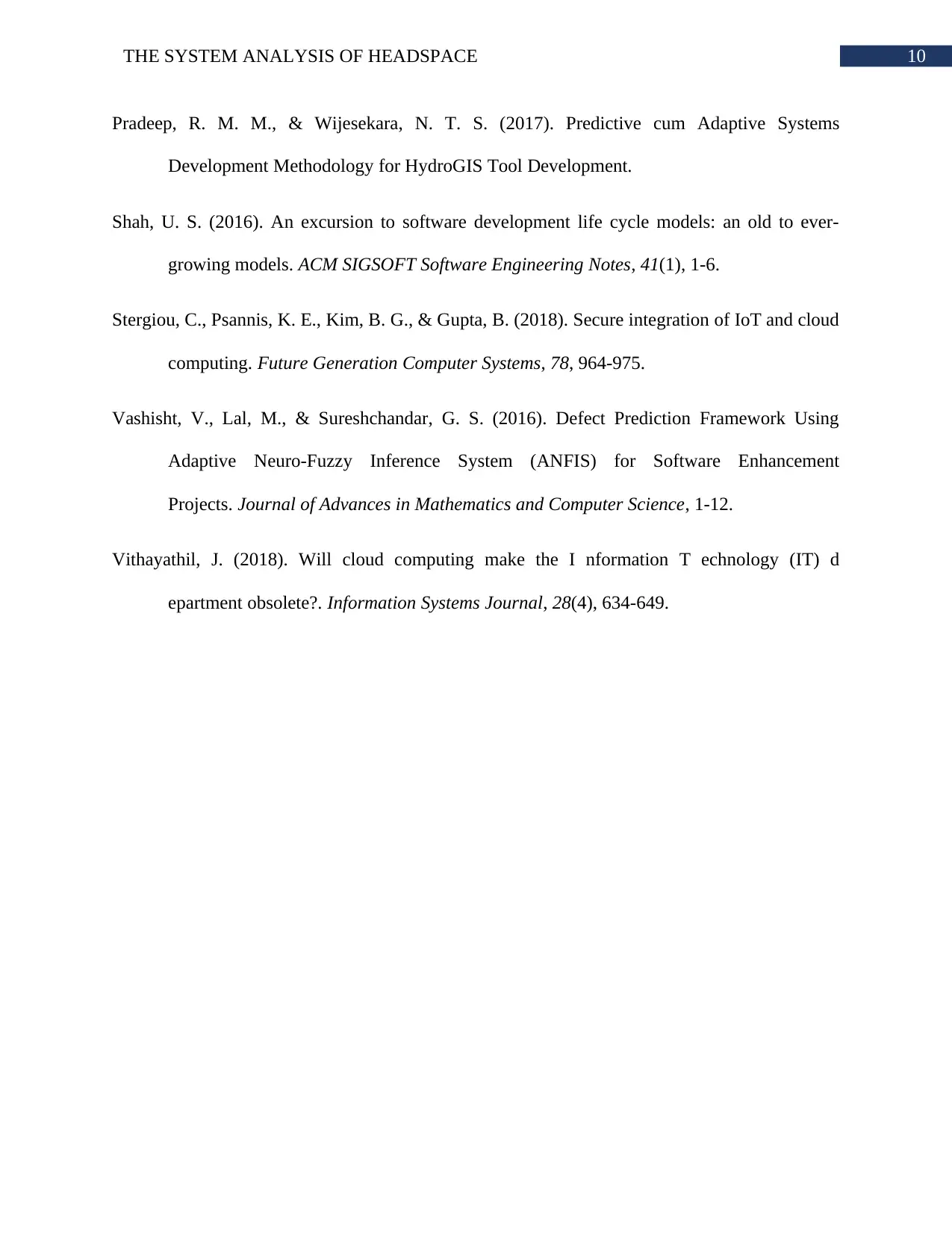
10THE SYSTEM ANALYSIS OF HEADSPACE
Pradeep, R. M. M., & Wijesekara, N. T. S. (2017). Predictive cum Adaptive Systems
Development Methodology for HydroGIS Tool Development.
Shah, U. S. (2016). An excursion to software development life cycle models: an old to ever-
growing models. ACM SIGSOFT Software Engineering Notes, 41(1), 1-6.
Stergiou, C., Psannis, K. E., Kim, B. G., & Gupta, B. (2018). Secure integration of IoT and cloud
computing. Future Generation Computer Systems, 78, 964-975.
Vashisht, V., Lal, M., & Sureshchandar, G. S. (2016). Defect Prediction Framework Using
Adaptive Neuro-Fuzzy Inference System (ANFIS) for Software Enhancement
Projects. Journal of Advances in Mathematics and Computer Science, 1-12.
Vithayathil, J. (2018). Will cloud computing make the I nformation T echnology (IT) d
epartment obsolete?. Information Systems Journal, 28(4), 634-649.
Pradeep, R. M. M., & Wijesekara, N. T. S. (2017). Predictive cum Adaptive Systems
Development Methodology for HydroGIS Tool Development.
Shah, U. S. (2016). An excursion to software development life cycle models: an old to ever-
growing models. ACM SIGSOFT Software Engineering Notes, 41(1), 1-6.
Stergiou, C., Psannis, K. E., Kim, B. G., & Gupta, B. (2018). Secure integration of IoT and cloud
computing. Future Generation Computer Systems, 78, 964-975.
Vashisht, V., Lal, M., & Sureshchandar, G. S. (2016). Defect Prediction Framework Using
Adaptive Neuro-Fuzzy Inference System (ANFIS) for Software Enhancement
Projects. Journal of Advances in Mathematics and Computer Science, 1-12.
Vithayathil, J. (2018). Will cloud computing make the I nformation T echnology (IT) d
epartment obsolete?. Information Systems Journal, 28(4), 634-649.
1 out of 11
Related Documents
Your All-in-One AI-Powered Toolkit for Academic Success.
+13062052269
info@desklib.com
Available 24*7 on WhatsApp / Email
![[object Object]](/_next/static/media/star-bottom.7253800d.svg)
Unlock your academic potential
Copyright © 2020–2025 A2Z Services. All Rights Reserved. Developed and managed by ZUCOL.




